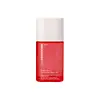What's inside
What's inside
 Key Ingredients
Key Ingredients

 Benefits
Benefits

 Concerns
Concerns

 Ingredients Side-by-side
Ingredients Side-by-side

Coco-Caprylate/Caprate
EmollientCrambe Abyssinica Seed Oil
Skin ConditioningDicaprylyl Ether
EmollientSqualane
EmollientSambucus Nigra Seed Oil
Passiflora Incarnata Seed Oil
Skin ProtectingTocopheryl Acetate
AntioxidantSalvia Hispanica Seed Oil
MoisturisingBorago Officinalis Seed Oil
EmollientVaccinium Vitis-Idaea Seed Oil
AntioxidantLupinus Albus Seed Extract
Skin ConditioningPalmitoyl Hexapeptide-12
Skin ConditioningPalmitoyl Tripeptide-1
Skin ConditioningEuterpe Oleracea Sterols
Skin ConditioningLinoleic Acid
CleansingLinolenic Acid
CleansingOleic Acid
EmollientSambucus Nigra Fruit Extract
AstringentBisabolol
MaskingTocopherol
AntioxidantHelianthus Annuus Seed Oil
EmollientCitrus Paradisi Peel Oil
MaskingCitrus Aurantium Dulcis Peel Oil
MaskingCitrus Nobilis Peel Oil
MaskingCitrus Limon Peel Oil
MaskingCymbopogon Citratus Leaf/Stem Oil
MaskingCaprylic/Capric Triglyceride
MaskingPentaerythrityl Tetraisostearate
EmollientPropylene Carbonate
SolventStearalkonium Hectorite
Gel FormingLimonene
PerfumingCitral
PerfumingCoco-Caprylate/Caprate, Crambe Abyssinica Seed Oil, Dicaprylyl Ether, Squalane, Sambucus Nigra Seed Oil, Passiflora Incarnata Seed Oil, Tocopheryl Acetate, Salvia Hispanica Seed Oil, Borago Officinalis Seed Oil, Vaccinium Vitis-Idaea Seed Oil, Lupinus Albus Seed Extract, Palmitoyl Hexapeptide-12, Palmitoyl Tripeptide-1, Euterpe Oleracea Sterols, Linoleic Acid, Linolenic Acid, Oleic Acid, Sambucus Nigra Fruit Extract, Bisabolol, Tocopherol, Helianthus Annuus Seed Oil, Citrus Paradisi Peel Oil, Citrus Aurantium Dulcis Peel Oil, Citrus Nobilis Peel Oil, Citrus Limon Peel Oil, Cymbopogon Citratus Leaf/Stem Oil, Caprylic/Capric Triglyceride, Pentaerythrityl Tetraisostearate, Propylene Carbonate, Stearalkonium Hectorite, Limonene, Citral
Prunus Amygdalus Dulcis Oil
Skin ConditioningCaprylic/Capric Triglyceride
MaskingParfum
MaskingOleyl Alcohol
EmollientCamelina Sativa Seed Oil
Skin ConditioningRosa Canina Fruit Oil
EmollientHelianthus Annuus Seed Oil
EmollientCitrus Aurantium Bergamia Fruit Oil
MaskingDaucus Carota Sativa Root Extract
Skin ConditioningHippophae Rhamnoides Fruit Oil
Skin ProtectingDioleyl Tocopheryl Methylsilanol
AntioxidantTocopherol
AntioxidantLimonene
PerfumingCoumarin
PerfumingLinalool
PerfumingCitral
PerfumingPrunus Amygdalus Dulcis Oil, Caprylic/Capric Triglyceride, Parfum, Oleyl Alcohol, Camelina Sativa Seed Oil, Rosa Canina Fruit Oil, Helianthus Annuus Seed Oil, Citrus Aurantium Bergamia Fruit Oil, Daucus Carota Sativa Root Extract, Hippophae Rhamnoides Fruit Oil, Dioleyl Tocopheryl Methylsilanol, Tocopherol, Limonene, Coumarin, Linalool, Citral
 Reviews
Reviews

Ingredients Explained
These ingredients are found in both products.
Ingredients higher up in an ingredient list are typically present in a larger amount.
This ingredient is an emollient, solvent, and texture enhancer. It is considered a skin-softener by helping the skin prevent moisture loss.
It helps thicken a product's formula and makes it easier to spread by dissolving clumping compounds.
Caprylic Triglyceride is made by combining glycerin with coconut oil, forming a clear liquid.
While there is an assumption Caprylic Triglyceride can clog pores due to it being derived from coconut oil, there is no research supporting this.
Learn more about Caprylic/Capric TriglycerideCitral is a fragrance and used to add a lemon-like scent to products. It is both naturally found in plants and created synthetically. In plants, it is commonly occurring in lemon myrtle, lemongrass, lemon tea-tree, lemon verbena, and other citruses.
The EU mandates Citral be listed separately as a fragrance. It is a known allergen and may cause contact dermatitis. Citral can also used as a masking ingredient.
The term 'fragrance' is not regulated in many countries. In many cases, it is up to the brand to define this term. For instance, many brands choose to label themselves as "fragrance-free" because they are not using synthetic fragrances. However, their products may still contain ingredients such as essential oils that are considered a fragrance.
The term 'citral' is a collective term for two geometric isomers: geranial/Citral A and neral/Citral B.
Learn more about CitralHelianthus Annuus Seed Oil is the oil derived from the seeds of a Sunflower. Sunflower seed oil is non-fragrant. It is an emollient, meaning it helps to soften the skin.
Sunflower seed oil contains many fatty acids. The fatty acids found in sunflower seeds include (from highest amount to least): linoleic acid, myristic acid, palmitic acid, stearic acid, arachidic acid, oleic acid, and linolenic acid.
These fatty acids help the skin create ceramides. Ceramides play a role in repairing the skin barrier.
Helianthus Annuus Seed Oil helps moisturize the skin. This in turn helps the skin look more rejuvenated and smoother.
Sunflowers are rich in vitamin E.
Historians believe Indigenous cultures of North America domesticated sunflowers before corn. Thus they relied on sunflower oil for a variety of uses. One such use is moisturizing skin and hair.
Sunflower seed oil may not be fungal acne safe. We recommend speaking with a professional if you have any concerns.
Learn more about Helianthus Annuus Seed OilLimonene is a fragrance that adds scent and taste to a formulation.
It's found in the peel oil of citrus fruits and other plants such as lavender and eucalyptus. The scent of limonene is generally described as "sweet citrus".
Limonene acts as an antioxidant, meaning it helps neutralize free radicals.
When exposed to air, oxidized limonene may sensitize the skin. Because of this, limonene is often avoided by people with sensitive skin.
The term 'fragrance' is not regulated in many countries. In many cases, it is up to the brand to define this term. For instance, many brands choose to label themselves as "fragrance-free" because they are not using synthetic fragrances. However, their products may still contain ingredients such as essential oils that are considered a fragrance.
Learn more about LimoneneTocopherol (also known as Vitamin E) is a common antioxidant used to help protect the skin from free-radicals and strengthen the skin barrier. It's also fat soluble - this means our skin is great at absorbing it.
Vitamin E also helps keep your natural skin lipids healthy. Your lipid skin barrier naturally consists of lipids, ceramides, and fatty acids. Vitamin E offers extra protection for your skin’s lipid barrier, keeping your skin healthy and nourished.
Another benefit is a bit of UV protection. Vitamin E helps reduce the damage caused by UVB rays. (It should not replace your sunscreen). Combining it with Vitamin C can decrease sunburned cells and hyperpigmentation after UV exposure.
You might have noticed Vitamin E + C often paired together. This is because it is great at stabilizing Vitamin C. Using the two together helps increase the effectiveness of both ingredients.
There are often claims that Vitamin E can reduce/prevent scarring, but these claims haven't been confirmed by scientific research.
Learn more about Tocopherol